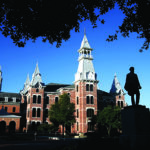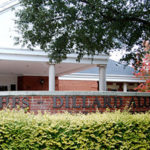More than 40 years after Baylor University in Waco and Baylor College of Medicine in Houston separated, the two institutions have begun talks regarding a strengthened relationship—but not without sparking controversy.
In a Jan. 21 letter to Baylor University faculty, staff and students, Interim President David Garland confirmed the university is “engaged in conversations with the Baylor College of Medicine in Houston and Texas Children’s Hospital regarding a strengthened affiliation.”
Garland noted the university’s belief the closer relationship with Baylor College of Medicine and Texas Children’s Hospital could help Baylor University’s continued growth and advancement. But, he insisted, no action would be taken that would “put our campus at undue risk,” and no decision would be made until parties involved completed due diligence.
“What is presently being discussed is a strengthened affiliation between the Baylor College of Medicine, Texas Children’s Hospital and Baylor University. Baylor University and the Baylor College of Medicine are not discussing a merger,” he said.
Reportedly, Baylor College of Medicine unsuccessfully had pursued an affiliation with Rice University in Houston.
Controversy regarding proposed closer ties with Baylor University surfaced about the same time Baylor College of Medicine ran into trouble with the National Institutes of Health for failing to disclose a cardiologist’s $34,000 consulting deal with a drug company—an apparent violation of conflict-of-interest policies for physicians conducting NIH-funded research.
Rumors of a merger between the college and Baylor University prompted some students, faculty, staff and alumni of Baylor College of Medicine to create an online petition to register opposition. More than 500 people have signed the statement, based on their belief Baylor University’s religious mission could stifle scientific research at Baylor College of Medicine.
Baylor University’s stated mission is “to educate men and women for worldwide leadership and service by integrating academic excellence and Christian commitment within a caring community.”
“As Baylor University is a religion-affiliated institution that promotes values and teachings from religious beliefs throughout its ranks, we cannot overlook the restrictive influence that this potential merger would have on Baylor College of Medicine, a leading biomedical research-oriented college,” the petition states.
Sign up for our weekly edition and get all our headlines in your inbox on Thursdays
“The religious ideologies that permeate throughout Baylor University’s academic policies may adversely affect both scientific progress and the culture at Baylor College of Medicine, particularly in relation to issues such as evolution, embryonic stem cells and sexual orientation. While we respect everyone’s right to religion in his or her own life, we believe that science and medicine must be separate from religion and urge you to reject any such merger.”
Garland responded: “Baylor University has an ambitious mission and vision that are unique among higher educational institutions. There are some who do not fully understand who and what we are.”
In his letter to faculty, staff and students, Garland sought to correct some of the “misstatements” and misunderstandings about the relationship between the university and Baylor College of Medicine.
“Since it originally affiliated with Baylor University in 1903, the Baylor College of Medicine has been a nonsectarian institution,” he wrote.
However, Baylor College of Medicine is affiliated with faith-based St. Luke’s Episcopal Hospital and Methodist Hospital, as well as Texas Children’s Hospital, DeBakey Veterans Affairs Medical Center, Harris County Hospital District’s Ben Taub General Hospital, the Menninger Clinic, Memorial Hermann-Institute for Rehabilitation and Research and M.D. Anderson Cancer Center.
Michael DeBakey—the cardiac surgeon and medical researcher who pioneered development of the artificial heart—joined the faculty at what was then the Baylor University College of Medicine in 1948, and he later served as president and chancellor of Baylor College of Medicine.
DeBakey and Abner McCall, then president of Baylor University, led in legally separating Baylor College of Medicine from the university in 1969.
“The university did this so that the college could attract broader, nonsectarian financial support and gain access to state and federal funding,” Garland explained.
At the time, the Baptist General Convention of Texas elected all the members of Baylor University’s governing board and set policy for the school—including a prohibition on accepting government funds.
“Baylor University has always been proud of its sectarian identity, but university regents realized its association with the BGCT could be limiting the college’s access to a range of financial resources. What’s more, regents concluded it was unreasonable to expect that the BGCT could continue to assume the financial burden of a growing medical school.”
Even after the university and Baylor College of Medicine separated, they retained some affiliation. Baylor University has appointed 25 percent of the Baylor College of Medicine board since 1969, Garland noted.
The Carnegie Foundation now classifies Baylor University as a research university with high research activity, and the university enrolls more than 500 Ph.D. candidates, he added. Baylor faculty receive $41 million in research grants, and annual research expenditures exceed $16 million.
“Baylor researchers are no longer prohibited from seeking or accepting federal or state funds to support their work,” Garland said. “Baylor’s tenure decisions include an expectation of academic scholarship and research productivity.”














We seek to connect God’s story and God’s people around the world. To learn more about God’s story, click here.
Send comments and feedback to Eric Black, our editor. For comments to be published, please specify “letter to the editor.” Maximum length for publication is 300 words.